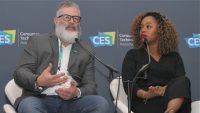CES Panel: Looking at 5G Use Cases and the Digital Divide
January 9, 2019
The recurring theme at CES 2019 is the promise of 5G wireless technology, as carriers such as Verizon begin their first moves into the space. Moderated by CTA’s Cindy Stevens, a group of technologists discussed some of the opportunities inherent in 5G networks for “hyper connectivity.” Microsoft principal group manager Pete Bernard noted that his company does not make 5G chips. “But we are an intelligent edge/cloud company,” he said. “5G is a catalyst technology that will enable our clients to move to the cloud more quickly.”
Samsung Electronics America VP business development & marketing Alok Shah (below, second from right) said his company has “this vision for connected living and 5G is a key enabling technology for that.” “We build mobile devices, network equipment, chipsets, so we can move the ecosystem forward,” he said. “We’re working with leading edge operators including Verizon, AT&T and Sprint on their 5G rollouts.”

Qualcomm Technologies VP of engineering John Smee (above, far right) said his company “views 5G as a transformative experience.” “It’s not only about smartphones coming in 2019 but how you scale into new markets, such as autonomous vehicles and industrial applications.”
Journalist and BLKTECHCLT and ThePLUG founder Sherrell Dorsey said her interest is “to interpret what these technologies will mean to consumers.” “How will 5G impact our lives,” she asked. “From the digital divide standpoint, who will be able to adopt 5G first? There are community activists trying to understand how everyone will have access. But there’s no perfect solution.”
Bernard (below left, with Dorsey) agreed that there’s a lot of effort around smart cities, but once they have that connectivity and applications, that will enable people without 5G to tap into a lot of these 5G-enabled systems. “I hope 5G raises all boats with cities’ infrastructure,” he said. “And telcos are very motivated to get people to shift over without a lot of pain.” Smee agreed that, “the 5G revolution will not leave rural areas behind.”

Smart city benefits will apply to the entire population, added Shah. “But even cell structure — they won’t get to every neighborhood, and how do we ensure it that certain zip codes receive that,” Dorsey added. “There has to be that intentionality around it if we talk about the digital divide piece. We’re going to have to think about how we’re designing the infrastructure.”
Smee said that fixed deployments augment mobile deployments, so the ability to connect to 5G won’t be limited to devices. “That could bring data rates to small businesses and enterprises and schools,” he said. “That’s where you open it to a wider swath for more consumers to benefit.”
Shah reported that a full 5G deployment will require “a whole combination of spectrum bands.” “We’ve been trialing systems around the world, and different frequency bands are used in different places,” he said. “In the field, the millimeter wave range that became feasible with technology advancements has done better than folks expected. It allows the economics of 5G rollout to work.”
He also noted that, “5G isn’t coming to market in a vacuum,” pointing out the integration of AI features. “There is a real opportunity to have a different paradigm where intelligent systems talk to other intelligent systems, especially valuable in the enterprise space,” he said. Smee added that the aspect of low latency will also be useful to the enterprise sector as well as municipalities moving to smart city applications.

No Comments Yet
You can be the first to comment!
Sorry, comments for this entry are closed at this time.